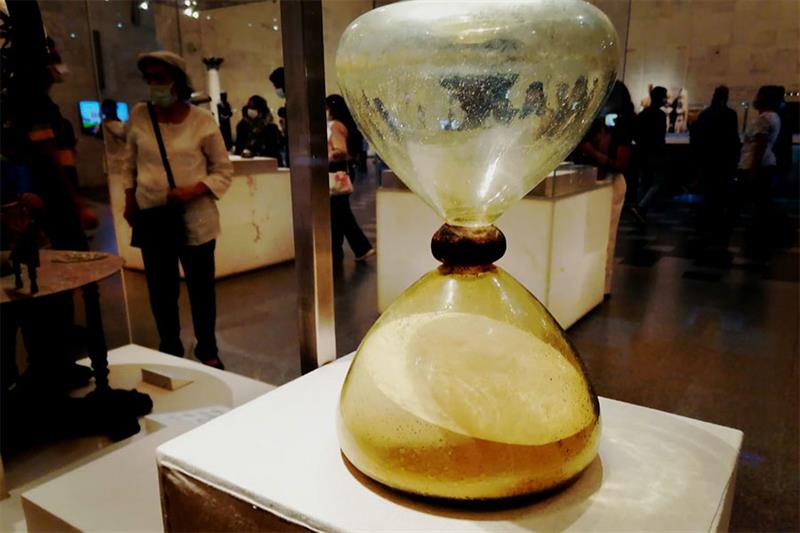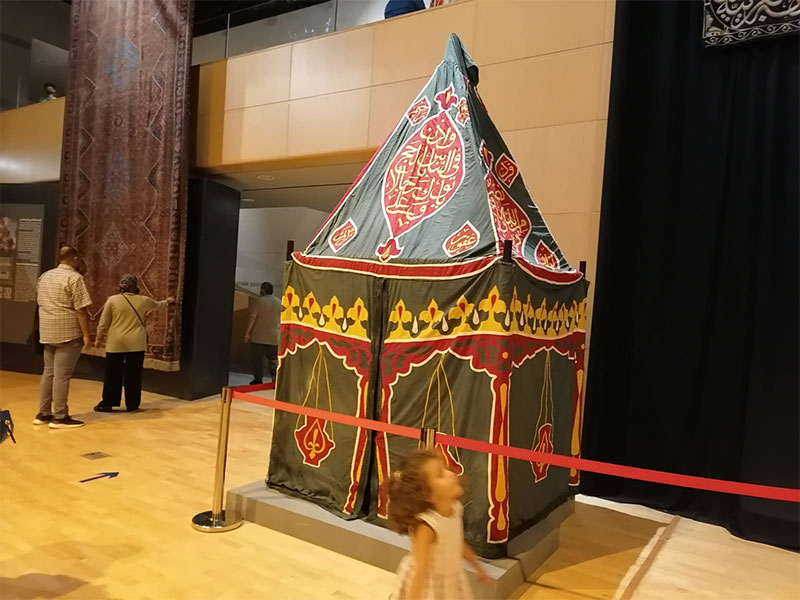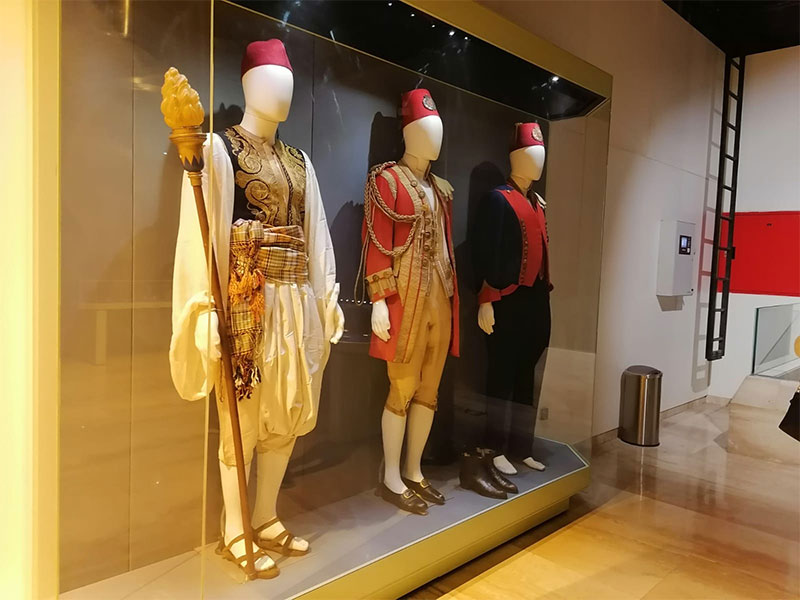
A sand hourglass in display in the National Museum of Egyptian Civilization. Photos by Amira Noshokaty
Set against the backdrop of the ancient Ein El-Sira in Fustat, the museum, which was inaugurated in 2021 with a massive mummy parade, beholds vibrant elements from all our multi-layered culture.
The Golden Ones

The three-storey building greeted us with the ground floor, the final destination of our Golden Pharos. The rounded hall beholds the mummies of our 22 Kings and Queens, along with their ornaments and legendary stories.
They are our ancient monarchs, who were first discovered by Ahmed Kamal Pasha, and were escorted to their final location through the lavish globally acclaimed Pharaohs Golden Parade.

The stairs then led us to the first floor, which displayed ancient Egypt’s medical excellence, skillful crafts, and trades.
From the papyrus of the famous fable of Sinuhi — one of the finest works of ancient Egyptian literature — to the meaning of the iconic Blue Ankh, or Key of Life, to the prosthetic toe that they managed to surgically implant, to the sharp delicate surgical instruments that resemble their modern counterparts; all reflecting the first civilisation’s great scientific and medical knowledge and skills.

The exhibition also showed remarkable accessories, make-up, board games, how they made wooden boats, coloured patched leather tents, and all the elements of ancient Egypt’s intangible heritage, down to some verses from the Hymns of Akhenaton, in which he addresses the creator, which adorned the walls next to one of his statues: “When you rise upon the horizon, the day breaks…”

Astronomy, the Kiswa, and Kabati textiles

On the opposite side of the ancient Egyptian relics lies segments of Coptic and Islamic culture. The exhibit featured astronomy, mathematical theories, and discoveries that etched in metal devices that deciphered the universal codes and managed to count the hours through grains of sands.
“The astrolabe, which is an astronomical device, consists of a disc, plate, net, and observer, and gives a handheld model of the universe,” read the description.
“It was invented by the Greek Astronomer Apollonious in the second century BC, then Thean of Alexandria developed it in the fourth century AD, Then Arab astronomers added to it the measures of angles and azimuth circles. Abu Ishaq Al-Fazari was the first to design the astrolabe in the Islamic world in the eighth century AD, while Mariam Al-Astrolabie invented the complex astrolabe in the tenth century AD.”

Next to the astronomy section was equally enchanting masterpieces that we inherited from our Coptic culture and still hand weave to this day stitch by stitch. The colorful stitches that stood the test of time gracefully and in full shape were recently enlisted on UNESCO’s list of intangible cultural heritage in need for urgent preservation.
Ferka and kabaty (Coptic) are authentic hand-made weaving styles that were passed on from the ancient Egyptians to the Coptic era.
Ferka had many forms and is known for its vibrant colours, while Kabaty textile leans towards white colour fabric that most ancient Egyptian royalties — like Queen Nefertiti— wore. It was the fabric from which the cover of the Muslim Holy Kabba was made and sent to Mecca every year.

The kiswa or Cover of the Kaaba that was sent in a grand ceremony from Cairo to Mecca for decades was on display with all its impeccable handmade weaving of Arabic calligraphy, as well as the mahmal (caravan) on which the Kiswa was kept during the annual procession to Mecca.
Side by side, we could also see the art of tent making in its original form in an old tent on display.


Women and customary attire

In another hall on the second floor, there was an exhibit for authentic female Egyptian customary attire. The display revealed the variation in styles from ancient Egyptian pure linen to the colorful stitches from Siwa to Sinai.
It revealed the rich diversity and roots that puts them all in complete harmony. It also resonated with traces of 5,000 years of multilayered culture in stitches and buttons.

Finally, the upper floor was dedicated to the jewelry and attire left by the descendants of Mohamed Ali Pasha, which included various military and police uniforms.
The NMEC’s hours of operation:
Saturday to Thursday from 9am to 5pm (Last ticket is sold at 4pm)
Fridays from 9am to 5pm and from 6pm to 9pm
Short link: